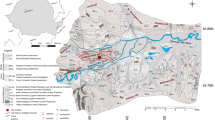Abstract
Disintegration of marl slopes in Israel is directly related to the climatic characteristics of the region even where water is not an obvious component of the environment. Seasonal contrasts between long, dry summers and short, wet winters are manifested by wide ranges in temperature (13–26°C) and water content (5−>42 percent) within the marl. These variations lead to both solution and aggregation of carbonate material in the marl.
Chemical disintegration in summer followed by mechanical disintegration in winter causes progressive weakening of the marl. The repeated wetting and drying results in the formation of an open texture in the marl.
Scanning electron microscope (SEM) observations made over several seasons on marl from freshly excavated slopes confirm the progressive disintegration from the slope's surface to a depth of at least 1.50 m. Solution holes, channels, and gaps between aggregates and matrix, formed during the summer, greatly increase the effective porosity and permeability of the marl. Water infiltration in the winter results in the mechanical washing out of fine material to the surface of the slope by throughflow and piping.
Similar content being viewed by others
References Cited
Aisenstein, B., D. David, and G. Wiseman, 1966, Mechanical properties of some marls in Israel: 1st Congress of Rock Mechanics, Lisbon, Portugal.
Arkin, Y., 1986, Geotechnical factors influencing marl slopes in Israel. Geological Survey of Israel Report GSI/97/86. Ph.D. thesis, London University, 386 p.
Arkin, Y., Y. Nathan, and A. Starinsky, 1972, Paleocene Early Eocene environment of deposition in the northern Negev (southern Israel). Geological Survey of Israel Bulletin No. 56.
Arkin, Y., and A. Starinsky, 1965, Unpublished columnar sections of the Ghareb Formation. Geological Survey of Israel, Jerusalem.
Bartov, Y., and Y. Arkin, 1979, Geophotomap of Israel on a scale of 1:500,000 based on ERTS imagery. Geological Survey of Israel, Jerusalem.
Baynes, F. J., and W. R. Dearman, 1978, Scanning electron microscope studies of weathered rocks: a review of nomenclature and methods. Bulletin of the Association of Engineering Geologists, v. 18, pp. 199–204.
Ben Yair, M., 1960, Studies on the weathering cycles of calcareous rocks in Israel. International Geology Congress, 21, Norden, Sept. Part 1, pp. 36–54.
Borst, R. L., and W. D. Keller, 1969, Scanning electron micrographs of A.P.I. reference clay minerals and other selected samples. Proceedings, International Clay Conference, Tokyo, v. 1, pp. 871–902.
Dan, J., 1977, The distribution and origin of nari and other lime crusts in Israel. Israel J. of Earth Science, v. 26, no. 2, pp. 68–83.
Flexer, A., 1971, Late Cretaceous paleogeography of northern Israel and its significance for Levant geology. Paleography, v. 10, pp. 293–316.
Garrels, R. M., and C. L. Christ, 1965, Solution, minerals and equilibrium: NY, Harper and Row.
Gillot, J. E., 1969, Importance of specimen preparation in microscopy. American Society for Testing and Materials Stp. 599, pp. 289–307.
Gipson, M. Jr., 1965, Application of the electron microscope to the study of particle orientation and fissility in shale. J. Sedimentary Petrology v. 35, no. 2, pp. 408–414.
Kennard, M. E., J. L. Knill, and P. R. Vaughan, 1967, The geotechnical properties and behavior of Carboniferous shale at the Balderhead Dam. Quarterly J. Engineering Geology, v. 1, pp. 3–24.
Minkoff, I., 1967, Application of scanning electron microscope in materials science. J. Material Science, v. 2, pp. 388–391.
Netterberg, F., 1982, Geotechnical properties and behavior of calcretes in south and west Africa.In K. R. Demars and R. C. Chaney, eds., Geotechnical properties, behavior and performance of calcareous soil: American Society for Testing and Materials 777, American Society for Testing and Materials, pp. 296–309.
Spears, D. A., and R. K. Taylor, 1972, The influence of weathering on the composition and engineering properties of in situ coal measures rocks. International J. of Rock Mechanics and Mineral Science, v. 9, pp. 729–756.
Taylor, R. K., and D. A. Spears, 1970, The breakdown of British coal measure rocks. International J. of Rock Mechanics and Mineral Science, v. 7, pp. 481–501.
Tourtelot, H. A., 1977, Geological origin and distribution of swelling clays. Association of Engineering Geology Bulletin, v. 11, no. 4, pp. 259–275.
Tovey, N. K., and W. K. Jan, 1973, The preparation of soils and other geological material for the SEM. Proceedings, International Symposium on Soil Structure, Gothenburg.
Yaalon, D. H., and S. Singer, 1974, Vertical variation in the strength and porosity of calcrete (nari) on chalk, Shefela, Israel, and interpretation of its origins. J. Sedimentary Petrology, v. 44, no. 4, pp. 1016–1023.
Author information
Authors and Affiliations
Rights and permissions
About this article
Cite this article
Arkin, Y. Disintegration of marl slopes in Israel. Environ. Geol. Water Sci 11, 5–14 (1988). https://doi.org/10.1007/BF02587757
Issue Date:
DOI: https://doi.org/10.1007/BF02587757




